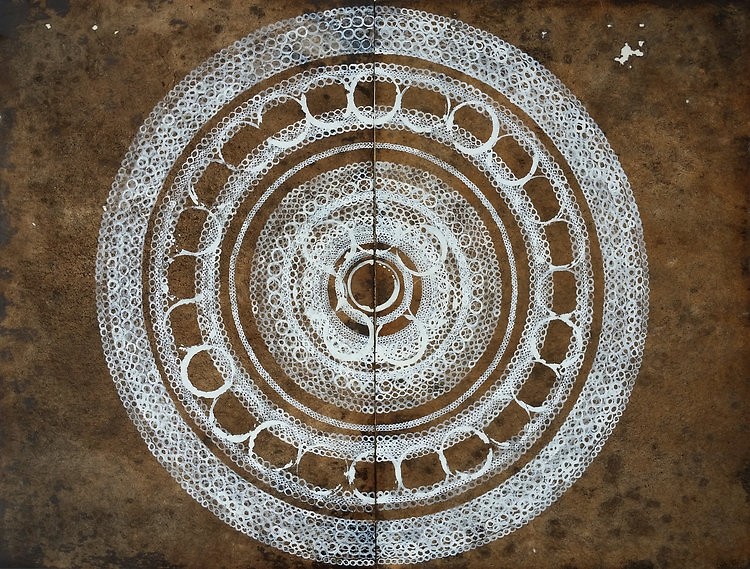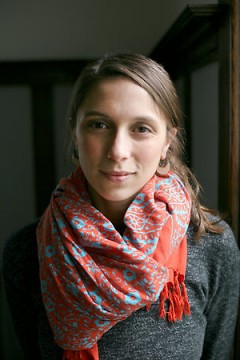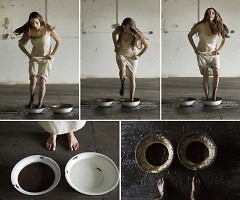Urban Institute for Contemporary Arts invites you to learn more about West Michigan's creative workforce, neighboring cultural organizations, and about ways to engage with Grand Rapids' art-scene with interviews and guest features highlighting our local and regional community members. Visit uica.org/learn for monthly interviews.
Her work has been shown in numerous venues including Van Der Plas Gallery (New York, NY), Index Art Center (Newark, NJ), the Wellin Museum (Clinton, NY), Maryland Institute College of Art (Baltimore, MD), the Ukranian Institute of Modern Art, (Chicago), The Museum of New Art (Detroit, MI), Hillyer Art Space (Washington, DC) and La Casa Pauly (Puerto Montt, Chile). Cano Villalobos has been an artist in residence at Vermont Studio Center, Post Contemporary, Wassaic Project, Ragdale, and ACRE. She has also received grants from multiple organizations including the Puffin and Frey Foundations. Her work has been reviewed in The Washington Post, Sculpture Magazine, Hyperallergic, Culturehall, Performa Magazine and Bad-at-Sports, among others. Cano Villalobos received her MFA from The George Washington University in Washington, DC.
How would you describe your work?
My work is formally versatile and conceptually coherent – at least, I would like to think so. I’m really interested in concepts of time: how we experience time, our understanding of chronological progression, corporate and personal memory, even a hope for an eternal Present that exceeds the elusiveness of passing time. A lot of my work reflects these ideas. Installations often explore a personal narrative that is set within a larger socio-historical context. Drawings are visual records of a repetitive process during which I try to open myself to the monotony of passing seconds, minutes, and hours. Similarly, I employ repetitious actions in my performances, transforming mundane gestures into a meditative ritual.
So, to give some examples, Undocumented Histories was a large scale installation I did with Site:Lab a few years ago. The project explored the personal histories of former Rumsey Street residents amidst societal change on the West Side of Grand Rapids. I collected all sorts of things people left behind – clothing, food, photographs, books, trinkets, even dentures – and created a home-like structure with a bed, kitchen area and front porch. I was trying to piece together the lives of those who were now absent. At the same time, the entire edifice had a make shift feel. It was an impermanent home that embodied the longing for permanence. In this way, Undocumented Histories spoke to the waning of the neighborhood, the private histories of past inhabitants, and the future renovations that would alter the entire community.
In my performance, Diminish: Brick, I file a brick to dust. The act itself is extremely boring and labor intensive. The back-and-forth movement, the unnoticeable progress, and the numbing of my hands reflect the greater question: why am I doing this? I’m quite literally breaking down the fundamental building block of human civilization. There’s a futility that undergirds so much of my work, a futility that I so often see in everyday life. Yet, for me, that dubious purpose goes hand-in-hand with a hope of resolution, of finding a significance in our work and life that exceeds our present comprehension. I reassign routine as ritual, discovering a transcendence within the commonplace.
Camus addresses a lot of these ideas in The Myth of Sisyphus, a book that has come to be very influential in the way I think about my art. In fact, a lot of my drawings are titled Sisyphus. Rather than concerning myself with the mere images I create, I’m very much invested in the ritualistic process of making those drawings. The Sisyphus series also uses my divorced parents’ wedding rings as a system of measurement, pitting the desires we have for marriage and family against the reality that confronts us. I employ ultramarine pigment, a color once derived from the precious lapis lazuli stone and incorporated in ancient manuscripts to symbolize Heaven. Now we can only get a cheap imitation blue. Again, there’s a desire for what is pure, or heavenly, but we always fall short. The hope and desire is there; the fulfillment is not.
So, really, my work touches upon personal and cultural memory, ritual, story, and longing. I wrestle with a desire for what you might call wholeness, or fulfillment, or redemption. All of that is conditioned by a cognizance of life’s ephemerality. I know my time on this earth is brief, and I simultaneously long for something that is unconditioned by my finitude.
Who or what has been the biggest single influence on your way of thinking?
Two experiences have really conditioned the way I think about things: my grandmother’s sudden death, and my military upbringing. When I was 6 months old my grandmother drowned. Because my mother and her sisters were still so young (my mom was 21), they have raised my generation with the constant awareness of our mortality. This ingrained understanding life’s temporary nature colors all I do.
Following my grandmother’s death, my mom joined the army. In total, I’ve lived in 14 states and I don’t know how many cities and army bases. As soon as I would make friends or come to think of a place as home, we would relocate. This transient lifestyle reinforced the sense that life is fleeting. Without any sort of generational or locational perpetuity, I’ve come to see life as a very temporary thing. That’s why my work often incorporates discarded items whose histories attest to their longevity, or songs and myths that have existed for decades or even centuries. I think that’s also why I had kids…
Do you have a piece of work which stands out in your mind as something you are exceptionally proud of or that is particularly important to you?
I’m particularly proud of the Elko Farm Project. This was one of my first major works after receiving my MFA from The George Washington University. At the time I adjuncted at four different institutions in the DC area. Exhausted, I would escape to visit family near Richmond, VA on the weekends. To get to my aunt and uncle’s house, I’d drive through country roads and past many different farms. There was one farm in particular that always caught my eye. It had a small white house, and several other buildings peppered with gorgeous oak trees. Coincidently, one day I was speaking with one of my students about location and home, and it turned out his grandmother owned that exact farm. My student introduced us and we soon began a collaboration that examined the history of their family, the history of the land, and the larger history of the rural South and its decline. I created an onsite installation at the farm, presenting these clouded histories through family photographs, personal possessions, land titles and farming tools. A curator from University of Maryland College Park took interest in the project and invited me to reinstall the work in their gallery. The night of the opening Mrs. Elko and her entire family surprised me by driving four hours to see the exhibition. They gave tours of the installation and showed gallery visitors how to use various plowing devices, and explained their familial lineage through school pictures and snapshots. I loved the confluence of art and non-art. So many viewers weren’t sure what to do. Here was a family that was touching the installation! They took things off the wall, they owned the work itself. The blurred boundaries threw everyone off guard, verging exhibition proper into the realm of social practice.
What new projects do you have on the horizon?
For years installation dominated my work. I’m now in process of modifying my practice to better meet my lifestyle needs. Last year I lost my studio, and without that space I am unable to regularly work on the large scale that I once did. I’ve tried to flip things around, turning my obstacles into opportunities. Right now, I’ve returned to my roots – painting, drawing and object-based genres. Lafontsee Galleries added me to their artist roster this year, and that has been both exciting and satisfying.
I’m continuing to produce Sisyphus drawings, experimenting with different colors, and referencing the global and cultural narratives that go along with those colors. (For example, white’s connotations of death, purity, power etc., contingent upon context). I’m also doing more performances, taking over industrial spaces that were once dominated by traditionally male activities, and enacting rituals that are intimate and domestic in nature. Grand Rapids has a lot of old factories that are either empty or repurposed for artist spaces. They’ve inspired a lot of my recent performances, and I’m looking forward to more this year.
What do you want others outside of the creative workforce to understand about careers within the arts?
This is the hardest question. I’d like to be able to concisely argue that the Arts are a necessity for the well being of contemporary society, but there’s nothing concise about that. Basically, I want to tell people that we live in an image-driven culture that is focused upon individualistic self-expression. How could the creative workforce NOT be a necessity?
Also, when we strip away career labels, we realize that creativity is fundamental to being human. This is not self-evident in a lot of vocations, and I think American society cultivates a mindset that separates “creative workforce” from other types of professions or areas of study. This separation fosters feelings of exclusion on both sides of a societally constructed line. To what extent do art professionals feel devalued and underpaid? To what extent do those not initiated with the Arts feel dismissed? It’s a very problematic way of thinking that maintains a long-standing dichotomy.
How can communities, specifically Grand Rapids, better support the creative workforce?
Reinstating an Arts Council would be a really good start. Whenever I tell art colleagues that Grand Rapids has no public committee dedicated to fostering local/regional arts, they look at me like I’m crazy. I mean, I think ArtPrize is doing an amazing job educating GR’s citizens and bringing world-class artists and curators to the city, but their mission is not the same as that of an arts council. Grand Rapids needs an arts council.
What are you passionate about besides your work?
My faith, my family, history, ice cream, British murder mysteries, and oldies.
What’s the best piece of advice you have heard and repeat to others?
“If you are bored by your work, no one else is going to be interested either”.
“Pay attention to what you pay attention to”.
“Americans try to get the most out of a day. Other cultures try to get the most out of a lifetime”.
“It’s not about you”.
Looking for more?
Learn more about the artist here.
The Rapidian, a program of the 501(c)3 nonprofit Community Media Center, relies on the community’s support to help cover the cost of training reporters and publishing content.
We need your help.
If each of our readers and content creators who values this community platform help support its creation and maintenance, The Rapidian can continue to educate and facilitate a conversation around issues for years to come.
Please support The Rapidian and make a contribution today.
Comments, like all content, are held to The Rapidian standards of civility and open identity as outlined in our Terms of Use and Values Statement. We reserve the right to remove any content that does not hold to these standards.


